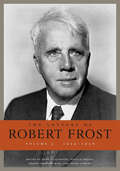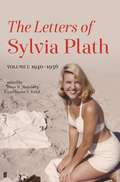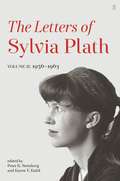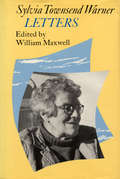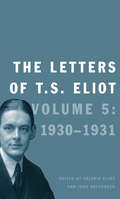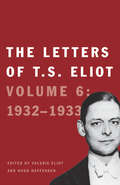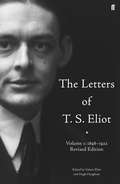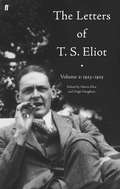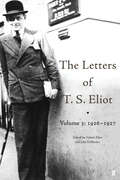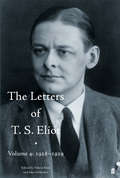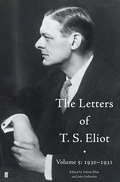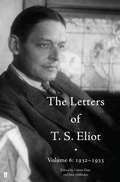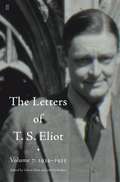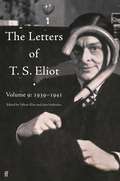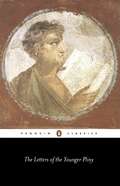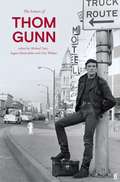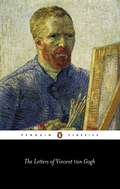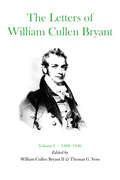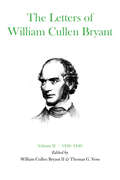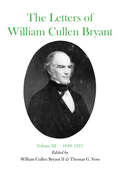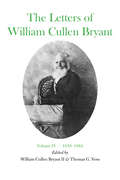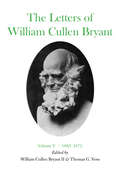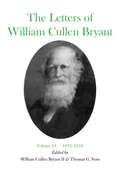- Table View
- List View
The Letters of Robert Frost, Volume 3: 1929-1936
by Robert FrostThe third installment of Harvard’s five-volume edition of Robert Frost’s correspondence. The Letters of Robert Frost, Volume 3: 1929–1936 is the latest installment in Harvard’s five-volume edition of the poet’s correspondence. It presents 589 letters, of which 424 are previously uncollected. The critically acclaimed first volume, a Times Literary Supplement Book of the Year, included nearly 300 previously uncollected letters, and the second volume 350 more. During the period covered here, Robert Frost was close to the height of his powers. If Volume 2 covered the making of Frost as America’s poet, in Volume 3 he is definitively made. These were also, however, years of personal tribulation. The once-tight Frost family broke up as marriage, illness, and work scattered the children across the country. In the case of Frost’s son Carol, both distance and proximity put strains on an already fractious relationship. But the tragedy and emotional crux of this volume is the death, in Montana, of Frost’s youngest daughter, Marjorie. Frost’s correspondence from those dark days is a powerful testament to the difficulty of honoring the responsibilities of a poet’s eminence while coping with the intensity of a parent’s grief. Volume 3 also sees Frost responding to the crisis of the Great Depression, the onset of the New Deal, and the emergence of totalitarian regimes in Europe, with wit, canny political intelligence, and no little acerbity. All the while, his star continues to rise: he wins a Pulitzer for Collected Poems in 1931 and will win a second for A Further Range, published in 1936, and he is in constant demand as a public speaker at colleges, writers’ workshops, symposia, and dinners. Frost was not just a poet but a poet-teacher; as such, he was instrumental in defining the public functions of poetry in the twentieth century. In the 1930s, Frost lived a life of paradox, as personal tragedy and the tumults of politics interwove with his unprecedented achievements. Thoroughly annotated and accompanied by a biographical glossary and detailed chronology, these letters illuminate a triumphant and difficult period in the life of a towering literary figure.
Letters of Sylvia Plath Volume I: 1940–1956
by Sylvia PlathSylvia Plath (1932-1963) was one of the writers that defined the course of twentieth-century poetry. Her vivid, daring and complex poetry continues to captivate new generations of readers and writers. In the Letters, we discover the art of Plath's correspondence, most of which has never before been published and is here presented unabridged, without revision, so that she speaks directly in her own words. Refreshingly candid and offering intimate details of her personal life, Plath is playful, too, entertaining a wide range of addressees, including family, friends and professional contacts, with inimitable wit and verve. The letters document Plath's extraordinary literary development: the genesis of many poems, short and long fiction, and journalism. Her endeavour to publish in a variety of genres had mixed receptions, but she was never dissuaded. Through acceptance of her work, and rejection, Plath strove to stay true to her creative vision. Well-read and curious, she offers a fascinating commentary on contemporary culture. Leading Plath scholars Peter K. Steinberg and Karen V. Kukil, editor of The Journals of Sylvia Plath 1950-1962, provide comprehensive footnotes and an extensive index informed by their meticulous research. Alongside a selection of photographs and Plath's own line-drawings, the editors masterfully contextualise what the pages disclose.This selection of early correspondence marks the key moments of Plath's adolescence, including childhood hobbies and high school boyfriends; her successful but turbulent undergraduate years at Smith College; the move to England and Cambridge University; and her meeting and marrying Ted Hughes, including a trove of unseen letters post-honeymoon, revealing their extraordinary creative partnership.
Letters of Sylvia Plath Volume II: 1956 – 1963
by Sylvia PlathSylvia Plath (1932-1963) was one of the writers that defined the course of twentieth-century poetry. Her vivid, daring and complex poetry continues to captivate new generations of readers and writers. In the Letters, we discover the art of Plath's correspondence. Most has never before been published, and it is here presented unabridged, without revision, so that she speaks directly in her own words. Refreshingly candid and offering intimate details of her personal life, Plath is playful, too, entertaining a wide range of addressees, including family, friends and professional contacts, with inimitable wit and verve.The letters document Plath's extraordinary literary development: the genesis of many poems, short and long fiction, and journalism. Her endeavour to publish in a variety of genres had mixed receptions, but she was never dissuaded. Through acceptance of her work, and rejection, Plath strove to stay true to her creative vision. Well-read and curious, she simultaneously offers a fascinating commentary on contemporary culture.Leading Plath scholar Peter K. Steinberg and Karen V. Kukil, editor of The Journals of Sylvia Plath 1950-1962, provide comprehensive footnotes and an extensive index informed by their meticulous research. Alongside a selection of photographs and Plath's own drawings, they masterfully contextualise what the pages disclose.This selection of later correspondence witnesses Plath and Hughes becoming major, influential contemporary writers, as it happened. Experiences recorded include first books and other publications; teaching; committing to writing full-time; travels; making professional acquaintances; settling in England; building a family; and buying a house. Throughout, Plath's voice is completely, uniquely her own.
Letters Of Sylvia Townsend Warner: Sylvia Townsend Warner Letters To Rachel, 1950-1952
by S WarnerVery early in her career Sylvia Townsend Warner won recognition of a discerning group of writers and readers on both sides of rare imagination and originality increased with each new publication. In addition to publishing some twenty books she wrote thousands of letters, mainly to close friends and acquaintances, and these quite naturally provide a record of almost fifty years of the writer’s life.As the editor of the selection says, she had a connoisseur’s eye for the bogus and a hatred for assumptions of privilege – her heart was with the hunted, always, and her deep understanding of human behaviour makes the whole a remarkably compassionate volume. Her interests are wide-ranging, and we read of the pleasures of travel, Proust’s shortcomings as a literary critic, current politics, Rupert Brooke at the Café Royal, an eccentric moorhen, the Spanish Civil War.Above all, apart from their intrinsic interest and literary quality, Miss Warner’s letters reveal the special brand of wit and humour that pervades every word she writes.
The Letters of T. S. Eliot: Volume 5: 1930-1931 (Letters Of T. S. Eliot Ser. #6)
by T. S. EliotThis fifth volume of the collected letters of poet, playwright, essayist, and literary critic Thomas Stearns Eliot covers the years 1930 through 1931. It was during this period that the acclaimed American-born writer earnestly embraced his newly avowed Anglo-Catholic faith, a decision that earned him the antagonism of friends like Virginia Woolf and Herbert Read. Also evidenced in these correspondences is Eliot’s growing estrangement from his wife Vivien, with the writer’s newfound dedication to the Anglican Church exacerbating the unhappiness of an already tormented union. Yet despite his personal trials, this period was one of great literary activity for Eliot. In 1930 he composed the poems Ash-Wednesday and Marina, and published Coriolan and a translation of Saint-John Perse’s Anabase the following year. As director at the British publishing house Faber & Faber and editor of The Criterion, he encouraged W. H. Auden, Stephen Spender, Louis MacNeice, and Ralph Hogdson, published James Joyce’s Haveth Childers Everywhere, and turned down a book proposal from Eric Blair, better known by his pen name, George Orwell. Through Eliot’s correspondences from this time the reader gets a full-bodied view of a great artist at a personal, professional, and spiritual crossroads.
The Letters of T. S. Eliot: Volume 6: 1932–1933 (Letters Of T. S. Eliot Ser. #6)
by T. S. EliotThe sixth volume of the personal correspondences of British literary giant T. S. Eliot The letters of T. S. Eliot collected in this sixth volume were written during the years the Nobel Prize–winning poet, playwright, critic, and essayist called, “the happiest I can ever remember in my life.” Penned in large part during his tour of Depression Era America, these letters reflect Eliot’s resolve to end his torturous eighteen-year marriage to his wife, Vivienne, and offer fascinating descriptions of the author’s encounters with F. Scott Fitzgerald, Edmund Wilson, Marianne Moore, and other notable figures.
The Letters of T. S. Eliot Volume 1: Volume 1: 1898-1922, Revised Edition (Letters of T. S. Eliot #1)
by T. S. EliotVolume One of the Letters of T. S. Eliot, edited by Valerie Eliot in 1988, covered the period from Eliot's childhood in St Louis, Missouri, to the end of 1922, by which time he had settled in England, married and published The Waste Land. Since 1988, Valerie Eliot has continued to gather materials from collections, libraries and private sources in Britain and America, towards the preparation of subsequent volumes of the Letters edition. Among new letters to have come to light, a good many date from the years 1898-1922, which has necessitated a revised edition of Volume One, taking account of approximately two hundred newly discovered items of correspondence.The new letters fill crucial gaps in the record, notably enlarging our understanding of the genesis and publication of The Waste Land. Valuable, too, are letters from the earlier and less documented part of Eliot's life, which have been supplemented by additional correspondence from family members in America.
The Letters of T. S. Eliot Volume 2: Volume 2: 1923-1925 (Letters of T. S. Eliot #2)
by T. S. EliotVolume Two covers the early years of his editorship of The Criterion (the periodical that Eliot launched with Lady Rothermere's backing in 1922), publication of The Hollow Men and the course of Eliot's thinking about poetry and poetics after The Waste Land. The correspondence charts Eliot's intellectual journey towards conversion to the Anglican faith in 1927, as well as his transformation from banker to publisher, ending with his appointment as a director of the new publishing house of Faber & Gwyer, in late 1925, and the appearance of Poems 1909-1925, Eliot's first publication with the house with which he would be associated for the rest of his life. It was partly because of Eliot's profoundly influential work as cultural commentator and editor that the correspondence is so prolific and so various, and Volume Two of the Letters fully demonstrates the emerging continuities between poet, essayist, editor and letter-writer.
The Letters of T. S. Eliot Volume 3: 1926-1927 (Letters of T. S. Eliot #3)
by T. S. EliotIn the period covered by this richly detailed collection, which brings the poet to the age of forty, T.S. Eliot was to set a new course for his life and work. Forsaking the Unitarianism of his American forebears, he was received into the Church of England and naturalised as a British citizen - a radical and public alteration of the intellectual and spiritual direction of his career.The demands of Eliot's professional life as writer and editor became more complex and exacting during these years. The celebrated but financially-pressed periodical he had been editing since 1922 - The Criterion - switched between being a quarterly and a monthly, before being rescued by the fledgling house of Faber & Gwyer. In addition to writing numerous essays and editorials, lectures, reviews, introductions and prefaces, his letters show Eliot involving himself wholeheartedly in the business of his new career as a publisher. His Ariel poems, Journey of the Magi (1927) and A Song for Simeon (1928) established a new manner and vision for the poet of The Waste Land and 'The Hollow Men'. These are also the years in which Eliot published two sections of an exhilaratingly funny, savage, jazz-influenced play-in-verse - 'Fragment of a Prologue' and 'Fragment of an Agon' - which were subsequently brought together as Sweeney Agonistes. In addition, he struggled to translate the remarkable work Anabase, by St.-John Perse, which was to be a signal influence upon his own later poetry.This correspondence with friends and mentors vividly documents all the stages of Eliot's personal and artistic transformation during these crucial years, the continuing anxieties of his private life, and the forging of his public reputation.
The Letters of T. S. Eliot Volume 4: Volume 4: 1928-1929 (Letters of T. S. Eliot #4)
by Valerie EliotVolume 4 of the letters of T. S. Eliot, which brings the poet, critic, editor and publisher into his forties, documents a period of anxious and fast-moving professional recovery and personal and spiritual consolidation. Following the withdrawal of financial support by his patron Lady Rothermere, Faber & Gwyer (subsequently Faber & Faber) eventually takes over the responsibility for Eliot's literary periodical The Criterion. He supplements his income as a fledgling publisher, 'just as I did ten years ago, by reviewing, articles, prefaces, lectures, broadcasting talks, and anything that turns up.' His work as editor is internationalist above all else, and Eliot makes contact with a number of eminent and emergent writers and thinkers, as well as forging links with European reviews ('all of which have endeavoured to keep the intellectual blood of Europe circulating throughout the whole of Europe'). Eliot's responsibilities during this period extend to caring for Vivien, who returns home after months in a French psychiatric hospital and whom he looks after with anxious fortitude; and the personal correspondence with his mother closes with her death in September 1929.
The Letters of T. S. Eliot Volume 5: Volume 5: 1930-1931 (Letters of T. S. Eliot #5)
by John Haffenden T. S. Eliot Valerie EliotThe letters between Eliot and his associates, family and friends - his correspondents range from the Archbishop of York and the American philosopher Paul Elmer More to the writers Virginia Woolf, Herbert Read and Ralph Hodgson - serve to illuminate the ways in which his Anglo-Catholic convictions could, at times, prove a self-chastising and even alienating force. 'Anyone who has been moving among intellectual circles and comes to the Church, may experience an odd and rather exhilarating feeling of isolation,' he remarks. Notwithstanding, he becomes fully involved in doctrinal controversy: he espouses the Church as an arena of discipline and order.Eliot's relationship with his wife, Vivien, continues to be turbulent, and at times desperate, as her mental health deteriorates and the communication between husband and wife threatens, at the coming end of the year, to break down completely. At the close of this volume Eliot will accept a visiting professorship at Harvard University, which will take him away from England and Vivien for the academic year 1932-33.
The Letters of T. S. Eliot Volume 6: 1932–1933 (Letters of T. S. Eliot #6)
by T. S. EliotDespairing of his volatile, unstable wife, T. S. Eliot, at 44, resolves to put an end to the torture of his eighteen-year marriage.He breaks free from September 1932 by becoming Norton Lecturer at Harvard. His lectures will be published as The Use of Poetry and the Use of Criticism (1933). He also delivers the Page-Barbour Lectures at Virginia (After Strange Gods, 1934). At Christmas he visits Emily Hale, to whom he is 'obviously devoted'. He gives talks all over - New York, California, Missouri, Minnesota, Chicago - and the letters describing encounters with F. Scott Fitzgerald, Edmund Wilson and Marianne Moore ('a real Gillette blade') brim with gossip. High points include the première at Vassar College of his comic melodrama Sweeney Agonistes (1932). The year 'was the happiest I can ever remember in my life . . . successful and amusing.'Returning home, he hides out in the country while making known to Vivien his decision to leave her. But he is exasperated when she buries herself in denial: she will not accept a Deed of Separation. The close of 1933 is lifted when Eliot 'breaks into Show Business'. He is commissioned to write a 'mammoth Pageant': The Rock. This collaborative enterprise will be the proving-ground for the choric triumph of Murder in the Cathedral (1935).
Letters of T. S. Eliot Volume 7: 1934–1935, The (Letters of T. S. Eliot #7)
by T. S. EliotT. S. Eliot's career as a successful stage dramatist gathers pace throughout the fascinating letters of this volume. Following his early experimentation with the dark comedy Sweeney Agonistes (1932), Eliot is invited to write the words of an ambitious scenario sketched out by the producer-director E. Martin Browne (who was to direct all of Eliot's plays) for a grand pageant called The Rock (1934). The ensuing applause leads to a commission from the Bishop of Chichester to write a play for the Canterbury Festival, resulting in the quasi-liturgical masterpiece of dramatic writing, Murder in the Cathedral (1935). A huge commercial success, it remains in repertoire after eighty years.Even while absorbed in time-consuming theatre work, Eliot remains untiring in promoting the writers on Faber's ever broadening lists - George Barker, Marianne Moore and Louis MacNeice among them. In addition, Eliot works hard for the Christian Church he has espoused in recent years, serving on committees for the Church Union and the Church Literature Association, and creating at Faber & Faber a book list that embraces works on church history, theology and liturgy. Having separated from his wife Vivien in 1933, he is anxious to avoid running into her; but she refuses to comprehend that her husband has chosen to leave her and stalks him across literary society, leading to his place of work at the offices of Faber & Faber. The correspondence draws in detail upon Vivien's letters and diaries to provide a picture of her mental state and way of life - and to help the reader to appreciate her thoughts and feelings.
The Letters of T. S. Eliot Volume 9: 1939–1941 (Letters Of T. S. Eliot Ser. #4)
by T. S. EliotThis volume covers the production of Eliot's play The Family Reunion; the publication of The Idea of a Christian Society; and the joyous versifying of Old Possum's Book of Practical Cats. After exhausting himself through nights of fire-watching in the London wartime blackout, he travels the country, attends meetings of The Moot, delivers talks, and advises a fresh generation of writers including Cyril Connolly, Keith Douglas, Kathleen Raine and Vernon Watkins. Major correspondents include W. H. Auden, George Barker, William Empson, Geoffrey Faber, John Hayward, James Laughlin, Hope Mirrlees, Mervyn Peake, Ezra Pound, Michael Roberts, Stephen Spender, Tambimuttu, Allen Tate, Michael Tippett, Charles Williams and Virginia Woolf. Four Quartets, Eliot's culminating masterpiece, is discussed in detail.
The Letters of the Younger Pliny: With Observations On Each Letter; And An Essay On Pliny's Life, Addressed To Charles Lord Boyle, Volume 2 (Penguin Classics Series)
by Betty Radice The Younger PlinyA prominent lawyer and administrator, Pliny (c. AD 61-113) was also a prolific letter-writer, who numbered among his correspondents such eminent figures as Tacitus, Suetonius and the Emperor Trajan, as well as a wide circle of friends and family. His lively and very personal letters address an astonishing range of topics, from a deeply moving account of his uncle's death in the eruption that engulfed Pompeii, to observations on the early Christians - 'a desperate sort of cult carried to extravagant lengths' - from descriptions of everyday life in Rome, with its scandals and court cases, to Pliny's life in the country.
The Letters of Thom Gunn
by Thom Gunn'Gunn's letters serve as one of the most indispensable epistolary chronicles of an era, especially in the US, of the Eisenhower fifties transforming into the revolutionary sixties and seventies, and then the revanchist, reactionary Reagan eighties and the AIDS epidemic, all seen through the lens of a gay, ex-pat English poet.' August KleinzahlerGunn was not just the leather jacket-wearing, motorbike-riding tough that he is sometimes made out to be; nor the rambunctiously laughing happy-go-lucky bon vivant that he often showed to the world. This correspondence, meticulously transcribed and annotated by the editors, charts his contradictions and complexities, bringing alive the biographical, political and poetic landscape that informed his imaginative and heroic body of work. The letters demonstrate not only the poet's role-playing and theatricality - recounting in various voices to share his experiences as fully as possible - but also a deep literariness and humane intelligence: friendship, Gunn himself remarks, 'must be the greatest value in my life'.
Letters of Two Brides
by Honoré De BalzacBy the French author, who, along with Flaubert, is generally regarded as a founding-father of realism in European fiction. His large output of works, collectively entitled The Human Comedy (La Comedie Humaine), consists of 95 finished works (stories, novels and essays) and 48 unfinished works. His stories are an attempt to comprehend and depict the realities of life in contemporary bourgeois France. They are placed in a variety of settings, with characters reappearing in multiple stories.
The Letters of Vincent Van Gogh: With Reproductions Of All The Drawings In The Correspondence (Penguin Classics Series)
by Vincent Van Gogh Ronald De LeeuwA new selection of Vincent Van Gough's letters, based on an entirely new translation, revealing his religious struggles, his fascination with the French Revolution, his search for love and his involvement in humanitarian causes.
The Letters of William Cullen Bryant: Volume I, 1809–1836
by William Cullen BryantThis is the only collection ever made of Bryant's letters, two-thirds of which have never before been printed. Their publication was foreseen by the late Allan Nevin as "one of the most important and stimulating enterprises contributory to the enrichment of the nation's cultural and political life that is now within range of individual and group effort.William Cullen Bryant (1794–1878) was America's earliest national poet. His immediate followers—Longfellow, Poe, and Whitman—unquestionably began their distinguished careers in imitation of his verses. But Bryant was even more influential in his long career as a political journalist, and in his encouragement of American art, from his lectures at the National Academy of Design in 1828 to his evocation of the Metropolitan Museum of Art in 1870. Between the appearance of his first major poem, "Thanatopsis," in 1817, and his death sixty-one years later at the age of eight-three, Bryant knew and corresponded with an extraordinary number of eminent men and women. More than 2,100 of his know letters have already been recovered for the present edition.When William Cullen Bryant signed the first of 314 letters in the present volume, in 1809, he was a frail and shy farm boy of fourteen who had nonetheless already won some fame as the satirist of Thomas Jefferson. When he wrote the last, in 1836, he had become the chief poet of his country, the editor of its principal liberal newspaper, and the friend and collaborator of its leading artists and writers. His collected poems, previously published at New York, Boston, and London, were going into their third edition. His incisive editorials in the New York Evening Post were affecting the decisions of Andrew Jackson's administration. His poetic themes were beginning to find expression in the landscape paintings of Robert Weir, Asher Durand, and Thomas Cole.The early letters gathered here in chronological order give a unique picture of Cullen Bryant's youth and young manhood: his discipline in the classics preparatory to an all-too-brief college tenure; his legal study and subsequent law practice; the experiments with romantic versification which culminated in his poetic masterpieces, and those with the opposite sex which led to his courtship and marriage; his eager interest in the politics of the Madison and Monroe Presidencies, and his subsequent activities as a local politician and polemicist in western Massachusetts; his apprenticeship as magazine editor and literary critic in New York City, from which his later eminence as journalist was the natural evolution; the lectures on poetry and mythology which foreshadowed a long career as occasional orator; the collaboration in writing The Talisman, The American Landscape, and Tales of Glauber-Spa, and in forming the National Academy of Design, and the Sketch Club, which brought him intimacy with writers, artists, and publishers; his first trip to the Aemrican West, and his first long visit to Europe, during which he began the practice of writing letters to his newspaper which, throughout nearly half a century, proved him a perceptive interpreter of the distant scene to his contemporaries.Here, in essence, is the first volume of the autobiography of one whom Abraham Lincoln remarked after his first visit to New York City in 1860, "It was worth the journey to the East merely to see such a man." And John Bigelow, who of Bryant's many eulogists knew him best, said in 1878 of his longtime friend and business partner, "There was no eminent American upon whom the judgment of his countrymen would be more immediate and unanimous. The broad simple outline of his character and career had become universally familiar, like a mountain or a sea."
The Letters of William Cullen Bryant: Volume II, 1836–1849
by William Cullen BryantThe second volume of William Cullen Bryant's letters opens in 1836 as he has just returned to New York from an extended visit to Europe to resume charge of the New York Evening Post, brought near to failure during his absence by his partner William Leggett's mismanagement. At the period's close, Bryant has found in John Bigelow an able editorial associate and astute partner, with whose help he has brought the paper close to its greatest financial prosperity and to national political and cultural influence.Bryant's letters lf the years between show the versatility of his concern with the crucial political, social, artistic, and literary movements of his time, and the varied friendships he enjoyed despite his preoccupation with a controversial daily paper, and with the sustenance of a poetic reputation yet unequaled among Americans. As president of the New York Homeopathic Society, in letters and editorials urging widespread public parks, and in his presidency of the New York Society for the Abolition of the Punishment of Death, he gave attention to public health, recreation, and order. He urged the rights of labor, foreign and religious minorities, and free African Americans; his most powerful political effort of the period was in opposition to the spread of slavery through the conquest of Mexico. An early commitment to free trade in material goods was maintained in letters and editorials, and to that in ideas by his presidency of the American Copyright Club and his support of the efforts of Charles Dickens and Harriet Martineau to secure from the United States Congress and international copyright agreement.Bryant's first visit to Great Britain came at the height of his poetic and journalistic fame in 1845, bringing him into cordial intimacy with members of Parliament, scientists, journalists, artists, and writers. In detailed letters to his wife, published here for the first time, he describes the pleasures he took in breakfasting with the literary patron Samuel Rogers and the American minister Edward Everett, boating on the Thames with artists and with diarist Henry Crabb Robinson, spending an evening in the home of Leigh Hunt, and calling on the Wordsworths at Rydal Mount as well as in the distinctions paid him at a rally of the Anti-Corn-Law League in Covent Garden Theatre, and at the annual meeting in Cambridge of the British Association for the Advancement of Science.Equally fresh are most of the letters to prominent Americans, many of them his close friends, such as the two Danas, Bancroft, Cole, Cooper, Dewey, Dix, Downing, Durand, Forrest, Greenough, Irving, Longfellow, Simms, Tilden, Van Buren, and Weir. His letters to the Evening Post recounting his observations and experiences during travels abroad and in the South, West, and Northeast of the United States, which were copied widely in other newspapers and praised highly by many of their subscribers, are here made available to the present-day reader.
The Letters of William Cullen Bryant: Volume III, 1849–1857
by William Cullen BryantDuring the years covered in this volume, Bryant traveled more often and widely than at any comparable period during his life. The visits to Great Britain and Europe, a tour of the Near East and the Holy Land, and excursions in Cuba, Spain, and North Africa, as well as two trips to Illinois, he described in frequent letters to the Evening Post. Reprinted widely, and later published in two volumes, these met much critical acclaim, one notice praising the "quiet charm of these letters, written mostly from out-of-the-way places, giving charming pictures of nature and people, with the most delicate choice of words, and yet in the perfect simplicity of the true epistolary style."His absence during nearly one-fifth of this nine-year period reflected the growing prosperity of Bryant's newspaper, and his confidence in his editorial partner John Bigelow and correspondents such as William S. Thayer, as well as in the financial acumen of his business partner Isaac Henderson. These were crucial years in domestic politics, however, and Bryant's guidance of Evening Post policies was evident in editorials treating major issues such as the Compromise of 1850, the Fugitive Slave Law, the Kansas-Nebraska Bill, the rise of the Republican Party, and the Dred Scott Decision, as well as in his correspondence with such statesmen as Salmon P. Chase, Hamilton Fish, William L. Marcy, Edwin D. Morgan, and Charles Sumner. His travel letters and journalistic writings reflected as well his acute interest in a Europe in turmoil. In France and Germany he saw the struggles between revolution and repression; in Spain he talked with journalists, parliamentary leaders, and the future president of the first Spanish republic; in New York he greeted Louis Kossuth and Giuseppe Garibaldi.Bryant's close association with the arts continued. He sat for portraits to a dozen painters, among them Henry P. Gray, Daniel Huntington, Asher Durand, Charles L. Elliott, and Samuel Laurence. The landscapists continued to be inspired by his poetic themes. Sculptor Horatio Greenough asked of Bryant a critical reading of his pioneering essays on functionalism. His old friend, the tragedian Edwin Forrest, sought his mediation in what would become the most sensational divorce case of the century, with Bryant and his family as witnesses. His long advocacy of a great central park in New York was consummated by the legislature. And in 1852, his eulogy on the life of James Fenimore Cooper became the first of several such orations which would establish him as the memorialist of his literary contemporaries in New York.
The Letters of William Cullen Bryant: Volume IV, 1858–1864
by William Cullen BryantThe years just before and during the Civil War marked the high point of Bryant's influence on public affairs, which had grown steadily since the Evening Post had upheld the democratic Jacksonian revolution of the 1830s. A founder of the Free Soil Party in 1848 and the Republican Party in 1856, Bryant was lauded in 1857 by Virginia anti-slavery leader John Curtis Underwood, who wrote to Eli Thayer, "What a glory it would be to our country if it could elect this man to the Presidency-the country not he would be honored & elevated by such an event."In 1860 Bryant helped secure the Presidential nomination for Abraham Lincoln, and was instrumental in the choice of two key members of his cabinet, Salmon Chase as Secretary of the Treasury, and Gideon Welles as Secretary of the Navy. During disheartening delays and defeats in the early war years, direct communications from Union field commanders empowered his editorial admonitions to such a degree that the conductor of a national magazine concluded that the Evening Post's "clear and able political leaders have been of more service to the government of this war than some of its armies."Bryant's correspondence with statesmen further reflects the immediacy of his concern with military and political decisions. There are thirty-five known letters to Lincoln, and thirty-two to Chase, Welles, war secretary Stanton, and Senators Fessenden, Morgan, and Sumner.This seven-year passage in Bryant's life, beginning with his wife's critical illness at Naples in 1858, concludes with a unique testimonial for his seventieth birthday in November 1864. The country's leading artists and writers entertained him at a "Festival" in New York's Century Club, giving him a portfolio of pictures by forty-six painters as a token of the "sympathy" he had "ever manifested toward the Artists," and the "high rank" he had "ever accorded to art." Poets Emerson, Holmes, Longfellow, Lowell, and Whittier saluted him in prose and verse. Emerson saw him as "a true painter of the face of this country"; Holmes, as the "first sweet singer in the cage of our close-woven life." To Whittier, his personal and public life sounded "his noblest strain." And in the darkest hours of the war, said Lowell, he had "remanned ourselves in his own manhood's store," had become "himself our bravest crown."
The Letters of William Cullen Bryant: Volume V, 1865–1871
by William Cullen BryantOn April 26, 1865, as Abraham Lincoln's funeral cortege paused in Union Square, New York, before being taken by rail to Springfield, Illinois, William Cullen Bryant listened as his own verse elegy for the slain president was read to a great concourse of mourners by the Reverend Samuel Osgood. Only five years earlier and a few blocks downtown, at Cooper Union, Bryant had introduced the prairie candidate to his first eastern audience. There his masterful appeal to the conscience of the nation prepared the way for his election to the presidency on the verge of the Civil War. Now, Bryant stood below Henry Kirke Brown's equestrian statue of George Washington, impressing Osgood as if he were "the 19tth Century itself thinking over the nation and the age in that presence." Bryant's staunch support of the Union cause throughout the war, and of Lincoln's war efforts, no less than his known influence with the president, led several prominent public figures to urge that he write Lincoln's biography. Oliver Wendell Holmes wrote him, "No man combines the qualities for his biographer so completely as yourself and the finished task would be a noble crown to a noble literary life." But Bryant declined, declaring his inability to record impartially critical events in which he had taken so central a part. Furthermore, while preoccupied with the editorial direction of the New York Evening Post, he was just then repossessing and enlarging his family's homestead at Cummington, Massachusetts, where he hoped his ailing wife might, during long summers in mountain air, regain her health. But in July 1866, Frances died of recurrent rheumatic fever, and, Bryant confessed to Richard Dana, he felt as "one cast out of Paradise." After France's death Bryant traveled with his daughter Julia for nearly a year through Great Britain and the Continent, where he met British statesman and novelist Edward Bulwer Lytton and French literary critic Hyppolyte Taine, renewed his friendship with Spanish poet Carolina Coronado, Italian liberator Giuseppe Garibaldi, and British and American artists, and visited the family of the young French journalist Georges Clemenceau, as well as the graves of earlier acquaintances Francis Lord Jeffrey and Elizabeth Barrett Browning. In his spare moments Bryant sought solace by beginning the translation of Homer, and Longfellow had found relief after his wife's tragic death by rendering into English Dante's Divine Comedy. Home again in New York, Bryant bought and settled in a house at 24 West 16th Street which would be his city home for the rest of his life. Here he completed major publications, including the Iliad and Odyssey of Homer and an exhaustive Library of Poetry and Song, and added to published tributes to earlier friends, such as Thomas Cole, Fenimore Cooper, and Washington Irving, memorial discourses on Fitz-Greene Halleck and Gulian Verplanck. In addition to his continued direction of the New York Homeopathic Medical college and the American Free Trade League, he was elected to the presidency of the Williams College Alumni Association, the International Copyright Association, and the Century Association, the club of artists and writers of which, twenty years earlier, he had been a principal founder and which he would direct for the last decade of his life.
The Letters of William Cullen Bryant: Volume VI, 1872–1878
by William Cullen BryantIn January 1872, Bryant traveled to Mexico City, where he was greeted warmly by President Benito Juarez; on this and other occasions he was feted for the Evening Post's sturdy condemnation in 1863 of the abortive invasion of Mexico, which was freshly remembered there. AT the close of his visit a local newspaper remarked that the "honors and hospitality which were so lavishly and generously conferred upon him were the spontaneous outpouring of a grateful people, who had not forgotten that when Mexico was friendless Mr. Bryant became her friend." Returning in April through New Orleans and up the Mississippi by steamboat to Cincinnati, he was greeted at a public reception by Governor Rutherford Hayes, who was pleased by his "winning and lovable" manners and "pithy" anecdotes.That spring Bryant built a library for his birthplace, Cummington, stocking it with several thousand books procured for him by the publisher George Palmer Putnam in New York and London. The following year, after the last of his many travels - this time a revisit to South Carolina and Florida - he made a similar gift to Roslyn. These benefactions won him honorary membership in the newly formed American Library Association, and an invitation to open a library at Princeton University, which made him an honorary doctor of letters. Ultimately, in the final year of his life, his plans for the Bryant Library at Cummington, solicited from the White House by President Hayes, provided the basic design for the first presidential library in the country - that established by Hayes in Fremont, Ohio.An improbable by-product of the presidential race in 1872 was a proposal by leading journalists that Bryant become -in his seventy-eighth year - a candidate to oppose President Grant and his challenger for the Republican nomination, the mercurial editor of the New York Tribune, Horace Greeley. Bryant's immediate refusal to take the suggestion seriously was succinct, and tinged with humor. It was impossible, he declared in his newspaper, that he should receive the nomination, and "equally impossible," if it were offered, that he should "commit the folly of accepting it." Four years later he was distressed at being unable to switch his journal's support of the Republican candidate Hayes to the Democratic candidate, his old companion in political reform, Samuel Jones Tilden.As Bryant approached and entered his eighties, his writing and public speaking continued without slackening. Between 1872 and 1878 he published his collected Orations and Addresses, edited a revision of his anthology of poetry and two volumes of landscape sketches, Picturesque America, co-authored a four-volume Popular History of the United States, and undertook to co-edit a three-volume set of Shakespeare's plays, while also producing long monographs on several seventeenth-century English poets. He dedicated statues of Shakespeare, Walter Scott, and Fitz-Green Halleck in Central Park, and spoke elsewhere on Robert Burns, Benjamin Franklin, Goethe, and Shakespeare, gave speeches on Mexico and "National Honesty," and presided over the founding of the State Charities Aid Association. He was honored in Albany at receptions by each house of the legislature. For his eightieth birthday, his life's work was celebrated in silver on a Tiffany vase given him by admirers throughout the country.Bryant's last public act was to unveil, in Central Park, his brainchild of nearly a half century earlier: a bust of the Italian patriot Giuseppe Mazzini. Here, after exhaustion under the June sun, he fell and suffered a massive concussion followed by a stroke, which led to his death a fortnight later in his eighty-fourth year. A period of virtual national mourning preceded his funeral and his burial beside his wife at Roslyn. At one of many memorial services, a eulogist exclaimed, "The broad outline of his character had become universally familiar, like a mountain or a sea. Whoever saw Bryant saw America."
